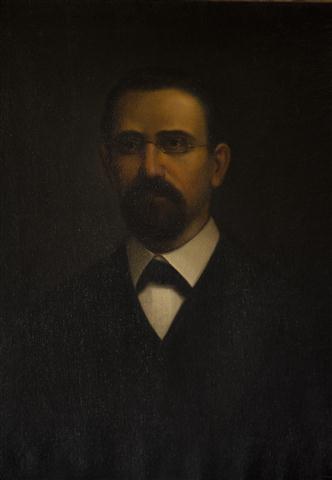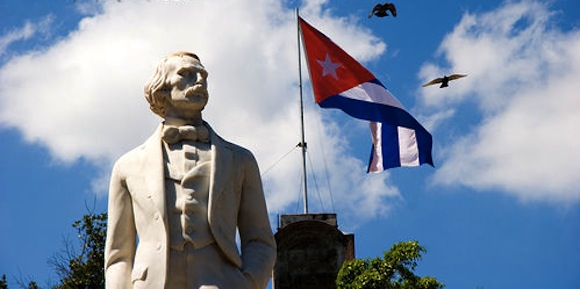Eusebio Leal Spengler ~ Historiador de la Ciudad de La Habana ~
Return to Cuba one of its most precious symbols
Ricardo Alarcón de Quesada, PhD, Speaker of the National Assembly, representing the President of the State Council and Government, General of the Army Raúl Castro; Homero Acosta, PhD, Secretary to the State Council; Miguel Barnet, PhD, deputy to the National Assembly and President of the National Union of Cuban Writers and Artists; Eduardo Torres Cuevas, PhD, Director of the National Library and deputy to the National Assembly; Margarita Ruiz, PhD, Director of the National Cultural Heritage Council; Raida Mara Suárez del Costal, Heritage Director under Havana City Historian’s Office,
I am honored to introduce to you Mr. Enrique Arturo Antonio Houston Touceda and his wife, as well as Judge Teresa Sánchez, PhD. Other guests are here with us today – museum directors and other distinguished personalities. Without a doubt, we are witness to an event of great historical significance, for one of Cuba’s most precious symbols has been returned to us. An eternal flame is burning in this room, in memory of all the sacrifice and suffering that the Cuban people have undergone to achieve absolute independence. On that day of June 1849 in New York City, a group of important figures met at an event of great significance for posterity – former Spanish Army General Narciso López, of Venezuela; his personal secretary – the outstanding Cuban writer Cirilo Villaverde; the distinguished poet Miguel Teurbe Tolón and his wife and first cousin Emilia, and General López’ aide-de-camp Juan Manuel Macías.
It is said – and it has remained so in written testimony by Cirilo Villaverde – that the General drew the design of what would be Cuba’s national flag on a blank sheet of paper. It necessarily made reference to two great political and historical events taking place at that time. First, the war of independence of the United States, which gave rise to their own flag. Then there was the French flag; the flag of 1789 rebel France in those three colors – red, blue and white, which stood for freedom, equality and fraternity. Immediately after he completed the sketch, which showed repeated signs that were without doubt familiar to those in attendance – the five-pointed star occupying the central space in the equilateral triangle and number five represented by blue and white stripes -, it was Teurbe Tolón – a good draftsman – who properly put it down on paper, and his wife sewed the flag using silk ribbons and a red fabric remnant. The triangle referred to the territories into which the island of Cuba was divided – East, West and Center – according to its military distribution, and the stripes evoked purity of ideas. The red triangle was also indicative of the blood that would be shed by the people. Once the design was completed, a flag of heroic proportions was hung on the façade of an American newspaper kiosk. Copies of it subsequently travelled to New Orleans and other regions.
Emilia brought her own flag to her birthplace of Matanzas inside a cushion, and it was later sent to Camagüey, and other parts of central Cuba, where it was raised by Isidoro Armenteros and Joaquín de Agüero. No one could ever forget those colors and symbols. Thus, the flag became a legend.
The following year, on 19 May 1850, an expedition made up of numerous people on board the vessel Creole, landed in Cárdenas [in Matanzas Province, Cuba], after having sailed the Mississippi and reached Isla Mujeres. It is understandable that on such a distant date – 18 years before the uprising led by Carlos Manuel de Céspedes – independence ideas did not have that sense of absolute purity that they would gain with time.
José Martí spoke of the blood with which it [the flag] was cleansed of initial commitments. Paradoxically, one year later in 1851, a second expedition to western Cuba brought that same leader [who was later] captured as a victim of treachery. That flag became the property of the Spanish army until it was returned by King Alfonso XIII’s royal decree, in reparation to the Cuban people, and out of respect to the full sovereign Republic they intended to build. This took place after General José Miguel Gómez’s visit to a military museum.
The other flag arrived later in 1916 when Elisa, daughter of Juan Manuel Macías, presented it to General Mario García Menocal, President of the Republic of Cuba at that time, who then entrusted it to national hero José Manuel Sanguily’s custody. It permanently became the nation’s property, and was placed in the Republic’s Senate room.
A third flag is currently at the Revolution Museum – the former Presidential Palace – and was brought by Narciso, the son of Cirilo Villaverde, author of the novel Cecilia Valdéz, in memory of his father. That is the third flag – the one with the eternal flame – as the 10 October events were crowned with immense sacrifice. The liberator was rightly called Father of the Cuban Nation. He was a notable lawyer and speaker, a poet and tireless traveller. He considered it to be necessary for his flag’s design, while keeping the same colors, and the star as an essential element, to be reminiscent of that of the Republic of Chile, on the basis of events taking place at that time which guided his decision.
However, the Cuban people’s solemn assembly (held on 10 April 1869 in Guáimaro) agreed that the Cuban flag should be this one – the old one, that of Narciso López and Joaquín de Agüero – and that the other one would be kept as a treasure by the Assembly, and would fly in its meeting room as the Republic’s foremost treasure. And so it was decided by the National Assembly, almost immediately after it met. That flag left Cuba under sad circumstances when President Céspedes – Father of the Cuban Nation – felt his life was in danger, and sent it to his wife Ana de Quesada (one of Doctor Alarcón’s ancestors); she brought it back to Cuba to take its rightful place at the House of Representatives of the Republic.
At this moment we have received the key symbol. On the equilateral triangle, the star is facing the tip of the flagpole – as described; in the center, the stamp of Juan Manuel Macías identifying one flag from the other; and the signature dated 19 May 1850 on Cuban soil.
The Havana City Historian – also Chairman of the National Monument Commission -, on behalf of both institutions, hereby expresses his heartfelt gratitude to Mr. Enrique Arturo Antonio Houston Touceda for handing over to the Flag Room in today’s Havana City Museum (the old Captains-General Palace), our National Flag, which has been in his family’s possession for 159 years, and was handed down to them through the bond of matrimony between Mrs. Alicia Macías and Mr. Antonio Touceda.
From that moment, the Cuban flag was handed down from one generation to another, as part of the estate of notable Cuban patriot Colonel Juan Manuel Macías who attended the meeting held in New York in 1849, as General Narciso López’ friend and collaborator. He accompanied the General on his failed expedition aboard steam ship Creole, which landed in Cárdenas city on 19 May 1850.
It has been recorded that when the contingent subsequently withdrew from their failed undertaking, Macías received a Cuban flag from the hand of Colonel O’Hara – who was a member of The Kentucky Regiment – on board the ship, and returned to the United States with it. This tradition has survived in the Touceda family.
It was both Mr. Enrique’s – and his wife Patricia’s – express wish, to bring it back to this place, where it will be permanently exhibited. Here is the flag (called Primus in Cuba), which was presented for the first time in New York City, shortly after it was made, and donated to President Mario García Menocal in 1916 by Mrs. Alicia Macías de Touceda, daughter of Cuban patriot Mr. Juan Manuel Macías.
Here also is the flag that was confiscated from General López’s expeditionary forces, upon their defeat not far from Frías coffee plantation in Las Pozas, Pinar del Río province, after they landed in Morrillo on board Pampero ship in 1851.
The Havana City Historian hereby expresses his gratitude to the memory of the Touceda family, represented by Mr. Enrique, considering that an unfinished chapter in the history of the National Heritage of the Republic of Cuba has now been closed with this event. I would like to express my deep appreciation to our President, General Raúl Castro, for having appointed the Speaker of the People’s Power National Assembly as his representative today, and to all government officials and friends of Cuba for their collaboration.
I would also like to express our sincere gratitude to Teresa Sánchez, PhD, the Judge from California, who has kindly visited us for this purpose. I wish to thank you, Joel, and all those who contributed to this endeavor from that part of the world. Our appreciation also goes to our Ministry for Foreign Affairs and all those who were involved in such a noble project.
I respectfully lay this wreath in memory of Juan Manuel Macías and all those who sincerely wanted Cuba’s freedom.
Thank you very much.
Compartir


